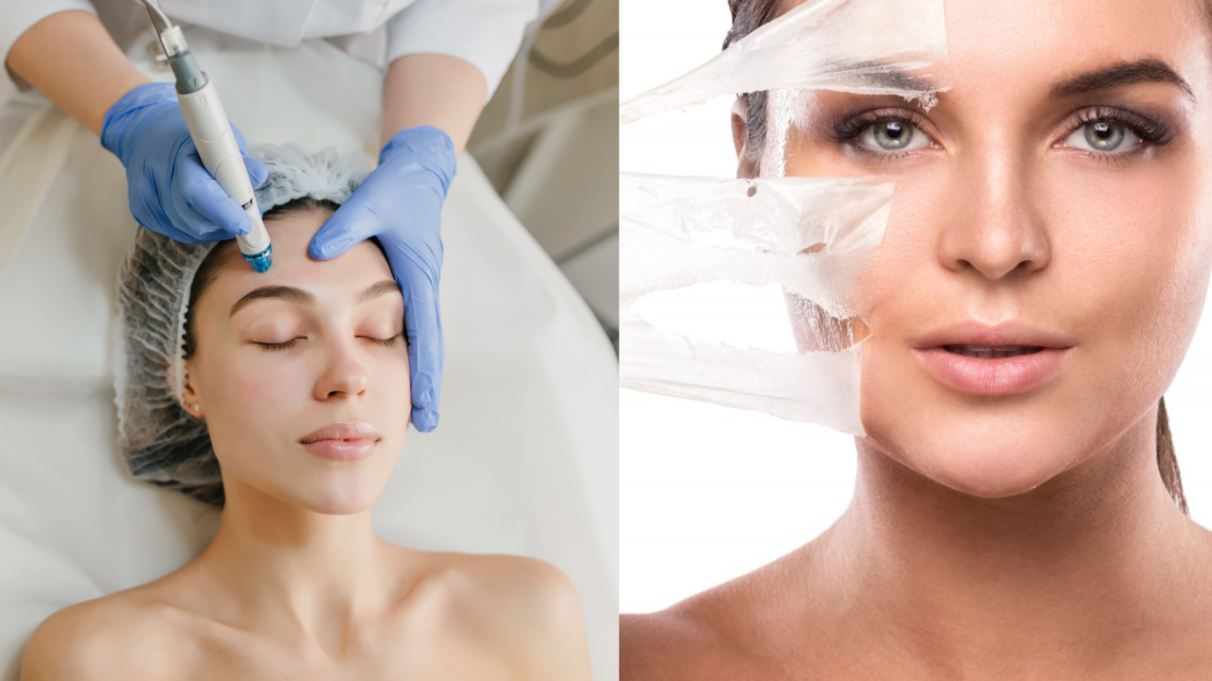You are looking to reduce scars, fine lines, or restore a radiant complexion, but you are hesitating between a chemical peel and microneedling? These two treatments promise results, but their mechanisms and effects vary. Don't worry: we will explain everything simply, as if we were discussing it over a coffee.
Understanding the Basics: Two Different Approaches
Chemical Peeling, a Controlled Exfoliation
Imagine a deep cleaning Chemical peeling uses acids (glycolic, salicylic, etc.) to remove the superficial layers of the epidermis. It's a bit like removing old paint to reveal a new and radiant surface of the skin.
- For whom ? Ideal for light imperfections (spots, enlarged pores) or fair skin.
- Visible results: Even complexion, refined texture, reduction of pigmentation spots [1].
Microneedling, a Mechanical Stimulation
With microneedling, fine needles create micro-injuries on the surface of the skin. These micro-wounds trigger a natural reaction: the skin produces collagen and elastin to repair itself, which tightens the tissues and reduces scars. [6][11].
- For whom ? Particularly suitable for dark skin (phototypes IV to VI) or deep scars (acne, chickenpox). [1][5].
- Key advantage: Less risk of depigmentation than with strong peels [1][2].
Efficiency Comparison: What Does Science Say ?
Acne Scars and Dark Skin: Microneedling Leads the Way
A study from Rutgers University (USA) compared the two methods on 60 patients with medium or dark skin. [1][2] I'm sorry, but it seems like your message is incomplete. Could you please provide more context or information for me to translate from French to English?
- 73% Patients undergoing microneedling have seen a significant reduction in their scars.
- 33% only with glycolic acid peels.
For dermatologists, this difference can be explained by the microneedling's ability to act deep without irritating melanin, which is responsible for dark spots on dark skin. [1][5].
Fair Skin and Pigment Spots: Peels Have an Advantage
Strong chemical peels (trichloroacetic acid) remain effective for fair skin tones, as they can exfoliate more intensely without risking depigmentation. [9]. One to two sessions are often enough for quick results on sun spots or fine lines.
Duration of Effects and Maintenance: What's the Difference ?
Chemical Peel: Quick Results, But Need to be Renewed
- Immediate effects: The skin peels for 2 to 5 days, revealing a fresh complexion.
- Duration: The results last for 6 to 12 months, depending on the depth of the peel.
- Risk: Deep peels require a longer recovery (redness, peeling) [9].
Microneedling: A Progressive and Lasting Solution
- Cumulative effects: Collagen replenishes over several weeks. Optimal results appear after 3 to 6 sessions. [5][11].
- Duration: The effects last 1 to 2 years, as collagen remains stable. [6].
What Treatment for Your Skin Type ?
Sensitive or Prone to Spots (Depending on Your Phototype)
- Phototypes I-III refers to different categories of skin types based on their sensitivity to sunlight. These classifications are used to determine the appropriate level of sun protection needed for each skin type. (Light skin): Chemical peels based on glycolic or salicylic acid are safe.
- Phototypes IV-VI
These terms refer to the Fitzpatrick scale, a classification system used to categorize the response of different skin types to ultraviolet (UV) light. Phototypes IV-VI correspond to individuals with darker skin tones that are less prone to sunburn and more likely to tan. (Dark to medium skin tones): Opt for microneedling to avoid the risks of depigmentation. [1][2].
Deep Scars vs Superficial Imperfections
- Indented scars (acne, chickenpox): Microneedling stimulates deep regeneration [5][11].
- Spots, enlarged pores A light peel is often sufficient.
After Treatment: The Golden Rules
After a chemical peel
- Protect yourself from the sun: The skin is more fragile to UV rays. Use SPF 50+.
- Avoid scrubs: Let the skin flake off naturally.
After a microneedling treatment
- Hydrate: Apply hyaluronic acid serums to support repair. [7].
- No makeup: Wait for 24 hours to let the micro-channels heal.
Our Recommendation: MCCM Salicylic Peel 20%
For an effective treatment against acne and imperfections, the MCCM Salicylic Peel 20% is an ideal solution. Thanks to its keratolytic and anti-inflammatory properties, this peel improves skin texture, tightens pores, and evens out the complexion.
Contrary to microneedling, which stimulates deep skin regeneration, salicylic peels work on the surface to eliminate dead cells and reduce excess sebum. It's an excellent option for blemish-prone skin looking for a smoother and more radiant complexion.
Discover the product
Conclusion: How to Choose in 3 Questions
- What is your skin type ? Dark skin → microneedling.
- What is the depth of your imperfections ? Superficial → peeling. Deep → microneedling.
- How much recovery time can you allow ? Emergency → light peeling. Please wait → microneedling.
Friendly advice: Consult a dermatologist or certified practitioner to personalize your treatment. And remember: there is no one-size-fits-all method. Sometimes, combining the two (alternatively) gives the best results. [9] ! !
Sources

Comments : 0